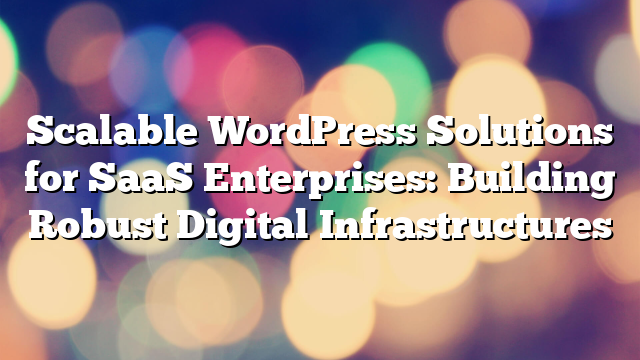How WordPress and Next.js Integration Empowers Enterprise Websites
02.12.2024

Enterprise websites demand speed, scalability, and flexibility to meet the growing expectations of users and business objectives. Combining the robust content management capabilities of WordPress with the performance and flexibility of Next.js creates a powerful solution for enterprises. This integration leverages the strengths of both platforms, resulting in highly performant, secure, and scalable websites. In this article, we’ll explore how WordPress and Next.js integration transforms enterprise websites and why it’s an ideal choice for modern businesses.
Why Combine WordPress and Next.js?
WordPress is a proven content management system (CMS) that powers over 40% of websites worldwide. Its user-friendly interface and extensive plugin ecosystem make it a go-to choice for enterprises. Next.js, on the other hand, is a React-based framework for building high-performance, server-rendered applications. By combining the two, enterprises can create websites that are both content-rich and lightning-fast.
Benefits of WordPress and Next.js Integration
1. Blazing-Fast Performance
Next.js uses static site generation (SSG) and server-side rendering (SSR) to deliver content faster. By decoupling the frontend from WordPress, enterprises can achieve reduced load times, better Core Web Vitals, and improved SEO rankings.
2. Enhanced Scalability
As enterprises grow, their websites must handle increasing traffic and complex functionalities. Next.js enables scalable architecture, while WordPress remains a reliable backend for managing content.
3. Improved Security
Decoupling WordPress and Next.js reduces the attack surface by limiting direct access to the WordPress backend. This ensures better security against vulnerabilities such as brute force and SQL injection attacks.
4. Superior Developer Experience
Next.js offers a modern development environment, complete with features like API routes, incremental static regeneration, and automatic code splitting. This simplifies the process of building dynamic, interactive enterprise websites.
5. Seamless User Experience
With Next.js handling the frontend, enterprises can create fully customizable, responsive, and interactive user interfaces that enhance the overall experience for visitors.
How the Integration Works
1. Using WordPress as a Headless CMS
In a headless setup, WordPress serves as the backend CMS for content creation and management. The frontend, built with Next.js, fetches content via the WordPress REST API or GraphQL.
2. Fetching Data with APIs
Next.js connects to WordPress through APIs, enabling the seamless retrieval of posts, pages, categories, and custom fields. This allows enterprises to dynamically populate their websites with up-to-date content.
3. Rendering Pages with Next.js
Next.js renders pages using static site generation (SSG) for optimal performance or server-side rendering (SSR) for dynamic content. Enterprises can mix and match these methods based on their needs.
4. Hosting and Deployment
The final website is hosted on platforms optimized for static and serverless applications, such as Vercel or AWS. This ensures scalability, reliability, and global content delivery.
Use Cases for WordPress and Next.js Integration
1. Enterprise Marketing Websites
Enterprises can use WordPress to manage content and Next.js to deliver a high-performance frontend. This setup is ideal for marketing websites where speed and user experience are critical.
2. E-Commerce Platforms
Integrating WooCommerce with WordPress and Next.js creates powerful e-commerce platforms. Next.js enhances performance and customization, while WordPress handles product catalogs and content.
3. Multilingual Websites
With WordPress plugins like WPML or Polylang, enterprises can manage multilingual content, while Next.js ensures smooth delivery of language-specific pages.
4. Content-Heavy Portals
Enterprises managing large volumes of content, such as news portals or knowledge bases, can benefit from the integration. Next.js ensures fast page loads, even for extensive content libraries.
5. Custom Applications
For enterprises needing bespoke functionalities, Next.js offers the flexibility to build custom applications while WordPress serves as a robust backend for content.
Challenges and Solutions
1. Complexity of Integration
Setting up WordPress and Next.js integration requires expertise in both platforms. Enterprises should work with experienced developers to ensure a smooth implementation.
2. API Rate Limits
Relying on APIs can lead to rate limiting, especially for high-traffic websites. Enterprises can use caching and static site generation to minimize API calls and improve performance.
3. Maintenance
Managing a decoupled architecture involves maintaining two separate systems. Automated deployment pipelines and monitoring tools can simplify maintenance and updates.
Best Practices for WordPress and Next.js Integration
1. Optimize API Usage
Use efficient API calls, caching, and incremental static regeneration to minimize load times and server strain.
2. Focus on Security
Restrict access to the WordPress backend, enforce HTTPS, and use secure API tokens to protect data and systems.
3. Leverage CDNs
Deploy static assets and dynamic content through a content delivery network (CDN) to ensure fast loading times across global regions.
4. Monitor Performance
Use performance monitoring tools to track website speed, server response times, and user interactions, ensuring consistent quality.
5. Plan for Scalability
Design the architecture to accommodate future growth, such as additional content types, features, or increased traffic.
Conclusion
The integration of WordPress and Next.js empowers enterprises to build websites that are fast, secure, and scalable, meeting the demands of today’s digital-first world. This combination allows businesses to leverage WordPress’s content management strengths while taking advantage of Next.js’s modern frontend capabilities.
Ready to transform your enterprise website with WordPress and Next.js integration? Contact AllWebDev today to explore how we can help you achieve your goals with this powerful technology stack.



